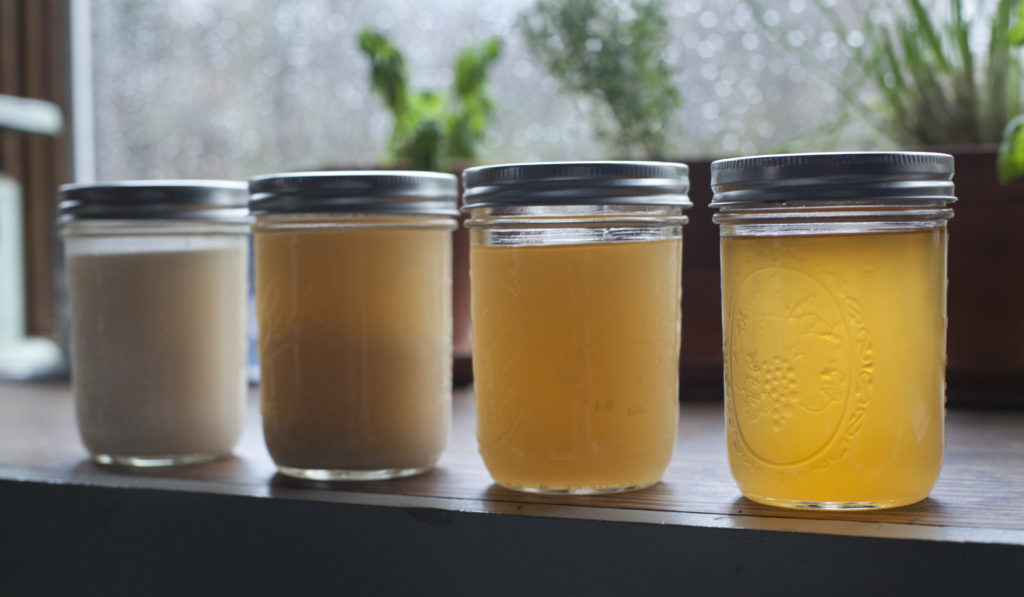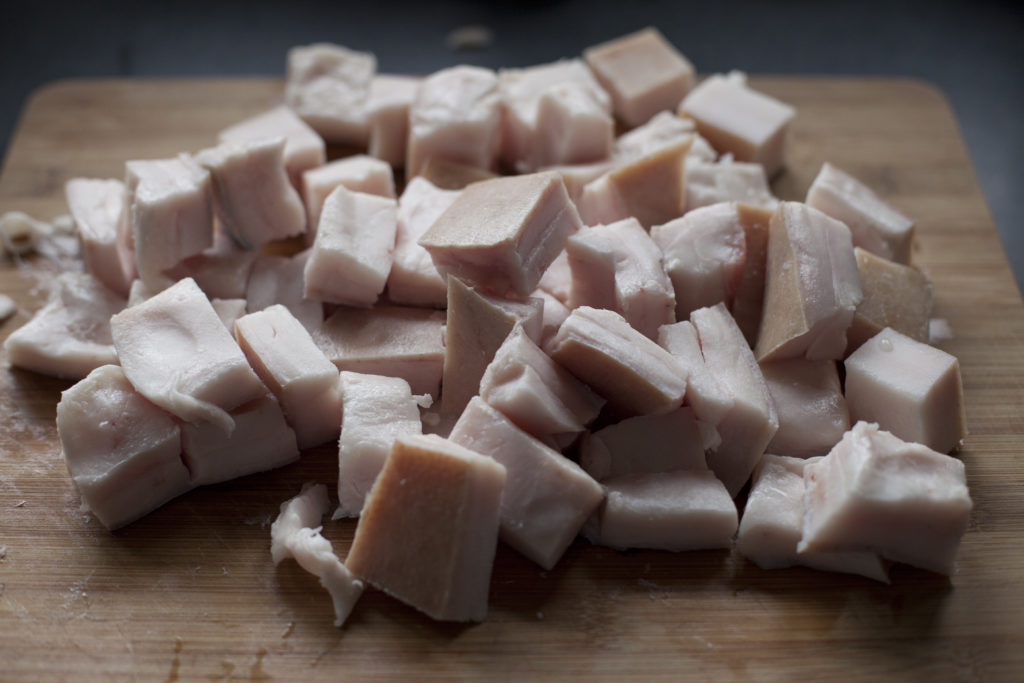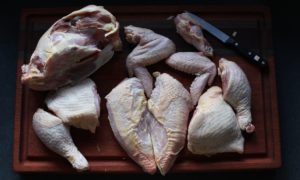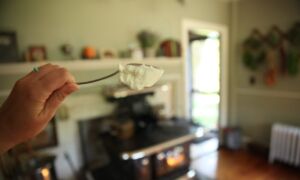It’s about time I finally wrote a blog post about my sweet sweet lard. It is no secret that I have a serious love for lard and how magical it is. A healthy animal fat that has been villainized due to the shift away from pastured pork to commercial factory farming has resulted in a general opinion that lard is an evil fat. Now, let me be clear. When I am speaking about all of the benefits of pork fat/lard, I am referring to pastured pork. Pigs raised outside, in the sun, rooting around in the soil and eating greens as nature intended. This does not apply to feedlot raised, barn stall raised, confined pork…because yes that is the villain.
Lard rendered from pastured pork is a healthy and stable animal fat. There is a perceived idea that lard is an artery clogging, heart attack causing, unhealthy fat. Yes, this is the case when you are talking about pigs raised in confined factory operations (CFO) or similar housing. But, we aren’t about those pigs here! Pigs store the vitamin D they get from spending all day in the sun and foraging on greens in their fat. Once rendered into lard, only a couple tablespoons a day can provide you with your daily requirement of liquid sun. Lard is also high in fatty acids such as oleic acid, and when you raise pastured pigs finished on acorns, the high level of omega-3’s they get from the acorns are stored in the fat as well! Lard also has a well balanced ratio of saturated: monounsaturated fats, and next to olive oil, it contains the highest quantity of monounsaturated fats of any cooking oil. I could go on and on, but I think you get the gist of it. Lard truly is a nutrient dense super fat in the kitchen.

So What Is It?
Lard simply put is pork fat rendered and clarified. So, you have solid pork fat that is very slowly melted (renders) where it collected, strained, and stored. Lard is a multipurpose cooking oil that can be used for sautéing, frying, and baking. However, not all pork fat is created equal. There really are two main types of fat that I personally use:
- Back fat: this is the thick fat layer that runs along the pig’s back and is attached to the skin. When rendered, back fat still can have a slight “piggy” flavor to it which doesn’t make it ideal for baking but is perfect for frying. French fries cooked in lard? Yummmmm
- Leaf fat: this is the soft fat found around the kidneys of the pig and is the purest and most neutral in flavor (you also get less of it than the back fat) When properly rendered, this highly coveted lard is wonderful in baked goods. Cookies, scones, pies, you name it. You haven’t lived until you’ve had a lard pie crust… there’s nothing that can top the tenderness and flakiness!
** Because of the differences in the lard caused by the types of fats I render them separately and label them so I know I don’t use my precious leaf lard for frying and vice versa!
The amount of fat that you get when processing can vary between hogs. While diet and age are major factors, another is the breed of pig. Pigs used to be categorized as either “lard pigs” or “bacon pigs”, but with the shift towards CFO’s, this designation isn’t really used anymore. Today, breeds such as Yorkshires aka “skinny/pink pigs” as I like to call them, are the choice hog for commercial pork industries. Why? Because they’re lean, and put on weight fast. Lean= no fat, so don’t expect to get much pork fat in a yorkshire or yorkshire cross. Heritage breeds are going to be your best bet to get the most pork fat, as well as the best marbling and flavor.
How To Render
So now that you have acquired your pasture raised pork fat (be it back fat, leaf fat, or both) it’s time to render it! Like I said above, I render mine separately so that I have my “baking” and “frying” lard, but if you choose to mix them together that’s your choice. One thing to note is that this is not a process you want to rush. Rushing leads to overcooking the fat which leads to less than ideal lard. When properly rendered, the cooled lard will have a snow white appearance. Any brown color means that it was overcooked. Still usable for frying or if you enjoy pork flavor in your baking! But, do yourself a favor and do this on a day that you know you’re going to be in or near the kitchen all day long.

- Cut your pork fat (skin, and chunks of meat attached are okay) into small chunks. Approximately an inch in size or less. Or, better yet if it’s ground! The smaller the pieces the quicker they will render down! **Pork fat is a solid at room temperature, however it isn’t necessarily easy to work with. I find it’s easiest to work with it partially frozen.
- Add cubed pork fat to a heavy bottom stockpot with 1/2 cup of cool water. With the lid off, turn the heat to medium low until it starts to melt, and then turn to low. Stir frequently. This will be the gist of your day. Going and checking on it to make sure that is very gently and slowly melting, stirring to prevent sticking, and rechecking it. You do not want to rush this. Resist the temptation to turn up the heat because if you overcook it, you get brown lard that has a strong piggy taste, not the snow white pure stuff. (if you do overcook it, it’s still okay to use for frying!)
- Continually ladle off the rendered fat and strain it through a filter into a jar if you’re there and being attentive. Continually ladling will prevent it from accidentally overcooking. Sometimes life doesn’t work out that way and we get sidetracked! If that’s the case, after several hours, once the stockpot is full of liquid rendered lard ladle off and strain through a filter. You should have hunks of pork skin, meat, etc floating on the top. These are the cracklings! Some people will fry these up, throw them under a broiler, and eat them as is or incorporate them into a meal. Me? I’m a softie and always give these to Annie as a special treat for all of her hard work taking care of the goats.
- Scoop out the cracklings and you now have a stockpot full of the yellow gold (should be a light yellow color if you didn’t overcook it), you will want to strain it through a fine mesh strainer to remove any large impurities followed by a couple layers of cheesecloth. You will be left with perfectly clarified lard! Throw it in your mason jars (I use wide mouth for easier scooping later) or whatever storage vessel you choose.
Storing Your Lard
Lard is a wonderful traditional and nutritious fat that frankly is my personal favorite. I know how we raise our pigs and how highly nutritious their meat and fat are. By rendering all of the back fat and leaf lard, I am minimizing waste as well as benefitting from the nutrition. I am always just about to run out when it comes time to process our next hog. Yes, I use it that much! So, let’s hear it for the lard and if you have never cooked with this highly nutritious fat, I can’t recommend it enough. Once you give it a try you’ll be hooked!



Pingback: Wild Mushroom & Herb Chicken with Chive Drop Dumplings | The Modern Day Settler
Oh. My. Word.
Proper drooling here! ?
Pingback: Flaky Lard Biscuits "Puff Style" - The Modern Day Settler
Ack! I’ve overcooked my precious Mangalitsa leaf lard! I rendered it in the slow cooker and woke in the night to the smell of cooking pork. I’m so sad. Is there any method to refine it in some way to save it? I _really_ wanted it for baking.
I appreciate any help.
You *can* use it for baking but it will definitely add a pork flavor to it. There is no way to save it once it’s gone beyond the point of just rendered. It is PERFECT for frying though! We have all done it, unfortunately!
Help! My pork lard has waived if brown in it. I’ve stored it in the fridge. My husband says it’s just sediment I didn’t filter out well. It doesn’t smell bad. I’m having a hard time deciding if I should use it. Thanks!
It sounds like sediment yes. You could rewarm it and strain it again!